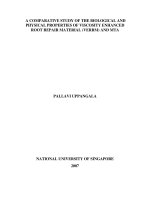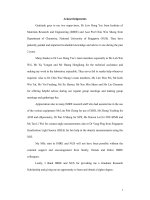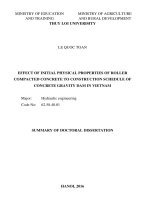4 11 properties of matter (physical science)
Bạn đang xem bản rút gọn của tài liệu. Xem và tải ngay bản đầy đủ của tài liệu tại đây (3.95 MB, 14 trang )
Physical Science
by Gregory K. George
Genre
Nonfiction
Comprehension Skill
Compare and
Contrast
Text Features
•
•
•
•
Labels
Captions
Charts
Glossary
Science Content
Matter
Scott Foresman Science 4.11
ISBN 0-328-13889-4
ì<(sk$m)=bdi ja< +^-Ä-U-Ä-U
Vocabulary
What did you learn?
chemical change
1. What are the most common states of matter?
density
mixture
bybalance
Gregory
George How does it
2. What is a pan
usedK.
to measure?
work?
physical change
3. Explain why condensation is a physical change.
solubility
4.
Sugar cubes dissolve in water.
On your own paper, explain how the solubility of a
sugar cube can be increased. Include details from the
book to support your answer.
5.
Compare and Contrast Suppose you have
two mixtures. One mixture is beads and water. The other
is salt and water. How are they alike? How are they
different?
Properties of Matter
solute
solution
solvent
Illustrations: 5, 20, 21 Big Sesh Studios
Photographs: Every effort has been made to secure permission and provide appropriate credit for
photographic material. The publisher deeply regrets any omission and pledges to correct errors called to its
attention in subsequent editions. Unless otherwise acknowledged, all photographs are the property of Scott
Foresman, a division of Pearson Education. Photo locators denoted as follows: Top (T), Center (C), Bottom
(B), Left (L), Right (R), Background (Bkgd).
Opener: PhotoLibrary; Title Page: (CC, TR) ©DK Images; 2 ©Kevin Schafer/Getty Images; 4 ©Bernhard
Edmaier/Photo Researchers, Inc.; 12 ©DK Images; 22 (CL, CR) ©Royalty-Free/Corbis, (BL) ©DK Images.
ISBN: 0-328-13889-4
Copyright © Pearson Education, Inc.
All Rights Reserved. Printed in the United States of America. This publication is
protected by Copyright and permission should be obtained from the publisher prior
to any prohibited reproduction, storage in a retrieval system, or transmission in any
form by any means, electronic, mechanical, photocopying, recording, or likewise. For
information regarding permissions, write to: Permissions Department, Scott Foresman,
1900 East Lake Avenue, Glenview, Illinois 60025.
3 4 5 6 7 8 9 10 V010 13 12 11 10 09 08 07 06 05
What is matter?
Properties of Matter
Matter is anything that has mass and takes up space. All
living and nonliving things are made of matter. Scientists use
the properties of matter to identify it. Your senses can help
you find many of these properties. You can see the color, size,
and shape of some matter. You can touch matter to tell if it is
smooth or rough. You can taste and smell some matter too.
Testing Matter
You can also test matter to find out about its
properties. How does it react if you heat or cool
it? Is it affected by a magnet? Does electricity
pass through it? If you hit it with a hammer,
does it break or just bend? If you put it in
water, does it sink or float? What happens if
you mix it with other matter?
Look at the ice and water.
What are some properties
that you can see?
2
3
Solids
States of Matter
Matter is made of tiny particles. These tiny particles can
move. They are also arranged in different ways. The way these
particles move and the way they are arranged tell the form,
or state, of the matter. The most common states of matter are
solid, liquid, and gas.
Most substances are found in just one state in nature. Water
is the most common substance that can be found naturally in
all three states of matter.
solid
An ice cube is solid water
that forms at temperatures
of 0°C or below. A solid is
any kind of matter that has
a definite shape and takes
up a definite amount of
space. The particles of a solid
are packed closely together.
Liquids
liquid
Water is a liquid. A liquid
is any kind of matter that
has no definite shape but
takes up a definite amount
of space. The particles of
a liquid are not packed as
closely together as particles
are in a solid. The particles
can slide past each other.
Gases
gas
4
Water vapor is an invisible
gas. Water vapor and other
gases make up the air around
us. A gas is any kind of matter
that has no definite shape and
does not take up a definite
space. The particles of a gas are
not close together. They move
in all directions.
5
How is matter measured?
Mass
You weigh more on
Earth than you would
on the Moon. Why is
that? Weight depends
on the force of gravity.
The Moon has less
gravity than Earth does.
So your weight on the
Moon would be less than it
is on Earth.
Mass does not change. Mass
is the amount of matter an
object has. Since mass stays the
same wherever an object is,
measuring mass is useful for
scientists. Mass changes
only if matter is added
or taken away.
Using a Pan Balance
A pan balance helps you find the mass of an object. You can
use a pan balance to compare a mass that you know with one
that you do not know. The masses are equal when the two sides
are level.
The mass of the toy in the picture is 23 grams. What if you
took the toy apart and measured each part? The mass of all
the parts would add up to 23 grams. The total mass of the parts
is equal to the mass of the toy that is put together.
The pan balance shows this. The toy is on one side of the pan
balance. It is in many pieces on the other side. Both sides have
a mass of 23 grams. The masses are equal. This would be true
even if all of the pieces were put together in a different way.
23 grams
23 grams
The mass of the toy is equal to the
total mass of its parts. The pan
balance is level.
6
7
Metric Units of Mass
Volume
Scientists do not use ounces and pounds
to measure matter. They use metric units.
The base unit of mass in the metric system
is the gram (g). Other metric units that are
often used are the milligram (mg) and the
kilogram (kg).
The metric system is based on tens. A
prefix before a base unit changes what it is
worth. For example, 1 gram is the same as
1,000 milligrams. A mass of 1,000 grams is
the same as a mass of 1 kilogram. A grape
has a mass of about 1 gram. A cantaloupe
has a mass of about 1 kilogram.
Volume is the amount of space that matter
takes up. When you take a deep breath, your
lungs expand. As they fill with air, their
volume increases.
You can use a metric ruler to measure the
length, width, and height of a solid, such as
a box. To find the volume, multiply these
numbers together. Suppose the length of a box
is 6 centimeters (cm), the width is 2 cm, and the
height is 5 cm. Then the volume of the box is
6 cm ϫ 2 cm ϫ 5 cm, or 60 cubic centimeters.
Like mass, volume is also measured in metric
units. Scientists use metric units such as the cubic
centimeter (cm3) and the cubic meter (m3) when
they measure solids. Look at the chart to see some
other metric units.
The mass of a
nickel is about 5 g.
The mass of a large
paper clip is about 1 g.
8
The mass of
the milk in this
carton is about
1,000 g, or 1 kg.
Comparing Metric Units of Length
Metric Unit
Equivalent
1 millimeter
0.001 meter
1 centimeter
10 millimeters
1 decimeter
10 centimeters
1 meter
100 centimeters or
1,000 millimeters
1 decameter
10 meters
1 hectometer
100 meters
1 kilometer
1,000 meters
9
Volume of Liquids
Volume of Other Objects
Unlike solids, liquids do not
have exact shapes. So when
scientists measure the volume of
a liquid, they use a measuring
container, such as a graduated
cylinder. Some metric units used
for volume are the milliliter (mL)
and the liter (L). A graduated
cylinder is marked with milliliters.
One liter is the same volume as
1,000 milliliters.
A graduated cylinder can measure the volume of a liquid
or a solid. A solid must sink in water in order for a graduated
cylinder to measure it. To measure the volume of a ball, fill a
graduated cylinder with water. Notice the height of the water.
Then put the ball in the water. Notice the new height of the
water. It is higher because the ball has pushed away some
of the water. The number of milliliters the water has risen is
equal to the volume of the ball. A volume of 1 mL is the
same volume as 1 cm3.
Examples of Metric Lengths
The water level rose 5 mL
when the ball was dropped in.
The volume of the ball is 5 mL.
10
What Was Measured
Measurement
Thickness of a CD
1 mm
Length of a paper clip
32 mm
Thickness of a CD case
1 cm or 10 mm
Height of a doorknob from the floor
1 meter
Length of a school bus
12 meters
Length of 440 blue whales placed
end to end
11 km or
11,000 m
Distance from the North Pole to
the equator
10,000 km
11
Density
Comparing Densities
You may need to know how
much mass is in a certain
volume of matter. Does steel
have more mass than wood?
To find out, you need to know
the sizes of the pieces of steel
and wood. You need an equal
volume of the objects you are
measuring. Density is the
amount of mass in a certain
volume of matter. If the pieces
of wood and steel are the same
size, then the steel has more
mass and more density than
the wood.
The density of an object tells
if the object will sink or float in
a liquid. Some liquids float on
other liquids. As you can see in
the picture, water floats on top of
corn syrup. The density of water is
less than the density of corn syrup.
Cooking oil floats on top of water.
So the density of cooking oil is less
than the density of water.
The grape is floating on top of
the corn syrup and at the bottom
of the water. This is because the
density of the grape is less than
the density of the corn syrup, but
more than the density of the water.
The cork has the least density of
anything in the container.
The density of an ice cube is a
little less than the density of water.
This makes the ice cube float. But
the difference in density between
water and an ice cube is very
small. So most of an ice cube is
below the surface.
Cooking oil
Finding Density
You divide the mass of an
object by its volume to find its
density. Like mass and volume,
density is measured in metric
units. The units to measure
density are grams per cubic
centimeter. Density is written as
mass in grams
a fraction: volume in cubic centimeters
g
or cm3 .
Water
Corn syrup
12
13
How do substances mix?
Mixtures
A mixture is a blend
of two or more substances.
These substances can easily
be separated. They are not
chemically combined.
Think of a bag of frozen
vegetables from the store.
The vegetables have been
combined into a mixture.
But they can be separated.
When the vegetables are
separated, they have the
same properties that they
had before they were mixed.
14
Look at the mixture of marbles,
beads, sand, safety pins, and salt. How
can these parts be separated? Safety
pins are attracted to a magnet. So
you can use a magnet to pull out the
safety pins. You pick out the marbles.
Then you can put the mixture in
water, to help separate what is left.
Some beads float to the top. You can
use a spoon to take those out. Then
you can pour the rest of the mixture
through a filter. The filter will separate
the sand and any remaining beads
from the water. You can evaporate the
water by heating it. Then the salt will
be left.
The properties of each of the
substances do not change when the
mixture is separated. Each substance
is the same as it was before it was
added to the mixture.
15
Solutions
Common Solutions
Salt and water stirred together
make a mixture. But you cannot
see the salt in the water. The salt
has dissolved. It has broken into
very small parts. The salt and water
have made a special mixture called
a solution. A solution is made
when one or more substances are
dissolved in another substance.
The most common kind of
solution is a solid dissolved in
a liquid. The substance that
is dissolved is the solute. In a
solution of salt and water, salt
is the solute. The substance that
takes in the other substance is the
solvent. In the salt and water
solution, the water is the solvent.
Ocean water is a solution.
A solution does not have to be
a liquid. The air we breathe is a
solution made of gases. Steel used
for buildings and cars is a solution
of carbon and iron.
Sand does not
dissolve in water.
The salt is
dissolved in
this solution.
Solubility
Solubility measures how much
of a substance will dissolve in
another substance. Sand does not
dissolve in water. This means the
solubility of sand in water is zero.
By raising the temperature of a
solvent, you can dissolve a solute
faster. It is easier to dissolve sugar
in warm water than in cold water.
Crushing a solute also makes it
dissolve faster. A sugar cube will
dissolve slowly in a cup of water.
The sugar cube will dissolve faster
if it is crushed first.
Salt dissolves
in water.
salt
sand
16
17
How does matter change?
Physical Changes
Origami is folding paper to make shapes. When you do
origami, you are not changing the particles that make up the
paper. You are only changing the size and shape of the paper.
Any change in the size, shape, or state of matter is a
physical change. In a physical change, the particles that
make up matter do not change. It is the arrangement of those
particles that changes.
Origami begins with a
plain square of paper.
Mixing salt and water is a physical change. The particles of
the salt and the water do not change when they mix. Salt and
water make a mixture. The parts of a mixture do not change,
and they can be separated. So making a mixture is a
physical change.
Another example of a
physical change is breaking a
pencil. The pieces of a broken
pencil have the same kinds of
particles as a pencil that is
in not broken.
Tearing a sheet of paper
is also a physical change.
No matter how many
pieces the sheet of paper
is in, it still has the
same particles that it
had before it was torn.
If you unfold the shape, you
will have the same piece of
paper you started with.
The paper is folded
many times.
18
The shape is finished.
19
Phase Changes
Water can be a liquid, a solid, or a gas. If you
melt solid water, or ice, it becomes liquid water.
If you heat water to a temperature of 100°C, it
becomes a gas, or water vapor. Liquid, solid, and
gas are called phases.
What causes matter to be in one phase and
not another? Energy causes particles to move
faster and farther apart. Adding or taking away
energy causes a substance to change phases.
You add energy to water when you heat it. You
take energy away from water when you freeze it.
Phase changes are physical changes.
328ºC
Lead melts.
1535ºC
Iron melts.
250ºC
Some wood
burns.
Effects of Temperature
on Matter
230ºC
Paper starts
burning.
100ºC
Water boils.
Water vapor
condenses.
0ºC
Water freezes into ice.
Ice melts into water.
20
Every substance changes phases at a different temperature.
The melting point or boiling point is a physical property. Each
helps identify a substance. Ice melts at 0°C. Lead melts at
328°C. A substance melts and freezes at the same temperature.
A substance evaporates and condenses at the same
temperature too. Evaporation is the change from a liquid to a
gas. Condensation is the change from a gas to a liquid.
When water evaporates or condenses, it is changing phase.
The mass of water does not change when it changes phase.
The particles of ice are close together. They do not move much.
Adding heat adds energy. The particles move more. Ice becomes
a liquid. Boiling water has even more energy. Particles move
even more. The liquid water changes to water vapor.
21
Chemical Changes
Elements
An iron nail will rust if it is in a damp place. If you compared
the iron nail to the rust, you would find that the nail and the
rust have different properties. Rust is a new, different substance.
It results from a chemical change. In a chemical change,
particles of one substance are changed to make particles of a
new substance with different properties. A chemical change is
taking place when wood burns or silver tarnishes.
The color of a substance may be different after a chemical
change. The substance may have a different smell. Its
temperature may change. Heat often comes from a chemical
change.
All particles in a pure substance are alike. The simplest pure
substances are elements. Information about the elements is
in a chart called the Periodic Table. The row and column the
element is in tells scientists about its properties. Each element
has a letter or letters as its symbol.
Elements are matter. In fact, everything is made of matter.
All matter can be measured. You can find out the mass,
volume, or density of any kind of matter. All matter can go
through chemical and physical changes.
The Periodic Table
Rust forms as oxygen
combines with the
iron in this gear.
Burning wood reacts
with oxygen to form
ashes, carbon dioxide
gas, and water vapor.
22
23
Vocabulary
Glossary
chemicalchange
change
chemical
density
mixture
density
physical change
solubility
mixture
solute
solution
physical change
solvent
What did you learn?
a change that occurs when the particles
of one substance change to make
particles of a new substance with
different properties
1. What are the most common states of matter?
the amount of mass in a certain volume
of matter
3. Explain why condensation is a physical change.
a blend of two or more substances whose
properties do not change when they are
combined
any change in the size, shape, or state of
matter
solubility
a measure of how much of a substance
will dissolve in another substance
solute
the substance that is dissolved in a
solution
solution
a combination that results when one or
more substances are dissolved in another
substance
Illustrations: 5, 20, 21 Big Sesh Studios
solvent
that
another
Photographs: Every effort has beenthe
madesubstance
to secure permission
anddissolves
provide appropriate
credit for
photographic material. The publisher deeply regrets any omission and pledges to correct errors called to its
substance
attention in subsequent editions. Unless otherwise acknowledged, all photographs are the property of Scott
Foresman, a division of Pearson Education. Photo locators denoted as follows: Top (T), Center (C), Bottom
(B), Left (L), Right (R), Background (Bkgd).
Opener: PhotoLibrary; Title Page: (CC, TR) ©DK Images; 2 ©Kevin Schafer/Getty Images; 4 ©Bernhard
Edmaier/Photo Researchers, Inc.; 12 ©DK Images; 22 (CL, CR) ©Royalty-Free/Corbis, (BL) ©DK Images.
ISBN: 0-328-13889-4
Copyright © Pearson Education, Inc.
All Rights Reserved. Printed in the United States of America. This publication is
protected by Copyright and permission should be obtained from the publisher prior
to any prohibited reproduction, storage in a retrieval system, or transmission in any
form by any means, electronic, mechanical, photocopying, recording, or likewise. For
information regarding permissions, write to: Permissions Department, Scott Foresman,
1900 East Lake Avenue, Glenview, Illinois 60025.
3 4 5 6 7 8 9 10 V010 13 12 11 10 09 08 07 06 05
24
2. What is a pan balance used to measure? How does it
work?
4.
Sugar cubes dissolve in water.
On your own paper, explain how the solubility of a
sugar cube can be increased. Include details from the
book to support your answer.
5.
Compare and Contrast Suppose you have
two mixtures. One mixture is beads and water. The other
is salt and water. How are they alike? How are they
different?









